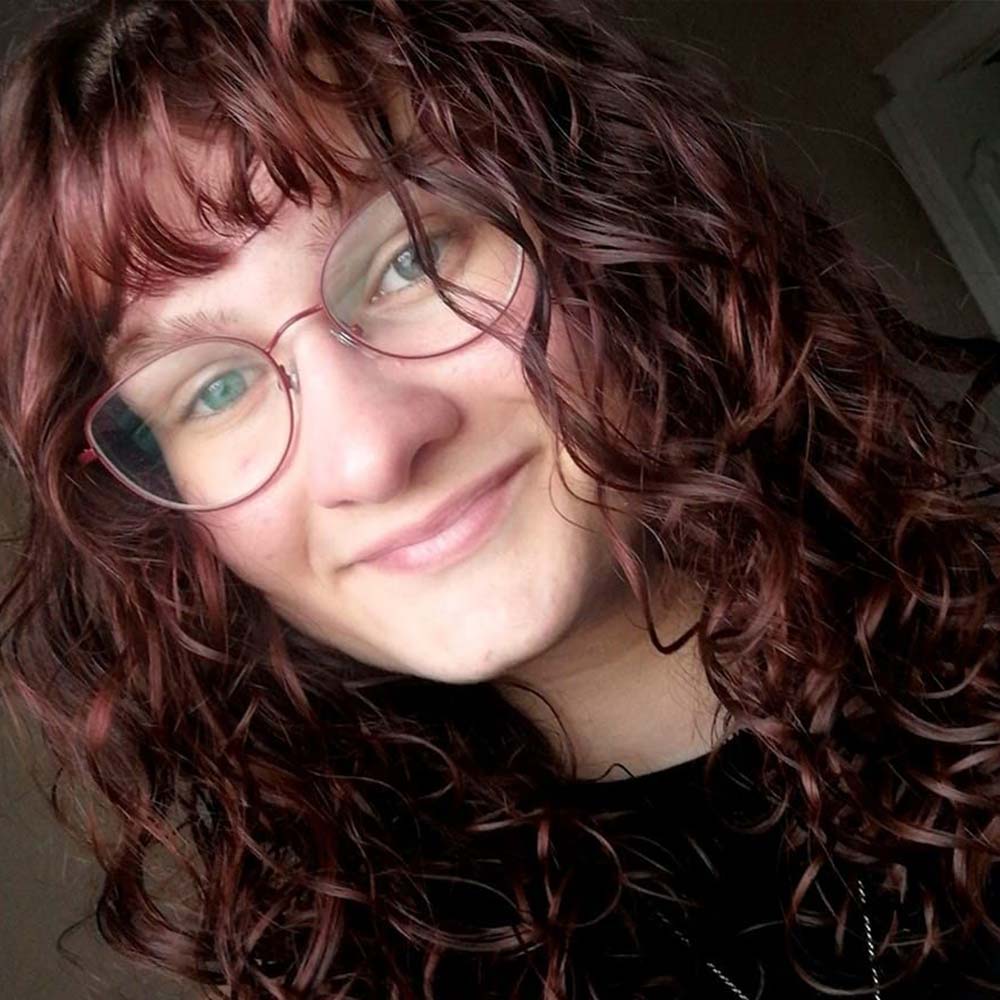- Home
- Castles in Germany
- Castles near Berlin
Discover the Majestic Castles near Berlin, Germany: A Regal Experience
By: Lydia Fulson / Writer, Pyrography Artist, Thrill Seeker, and Traveler
Attention travelers, we've reached another part of Germany that can't be missed. Well, it's hard to miss, as Berlin is the German capital. It may be the largest city, but it is, in fact, the smallest state in the entire country!
But don't be fooled. This state holds more than one may think.
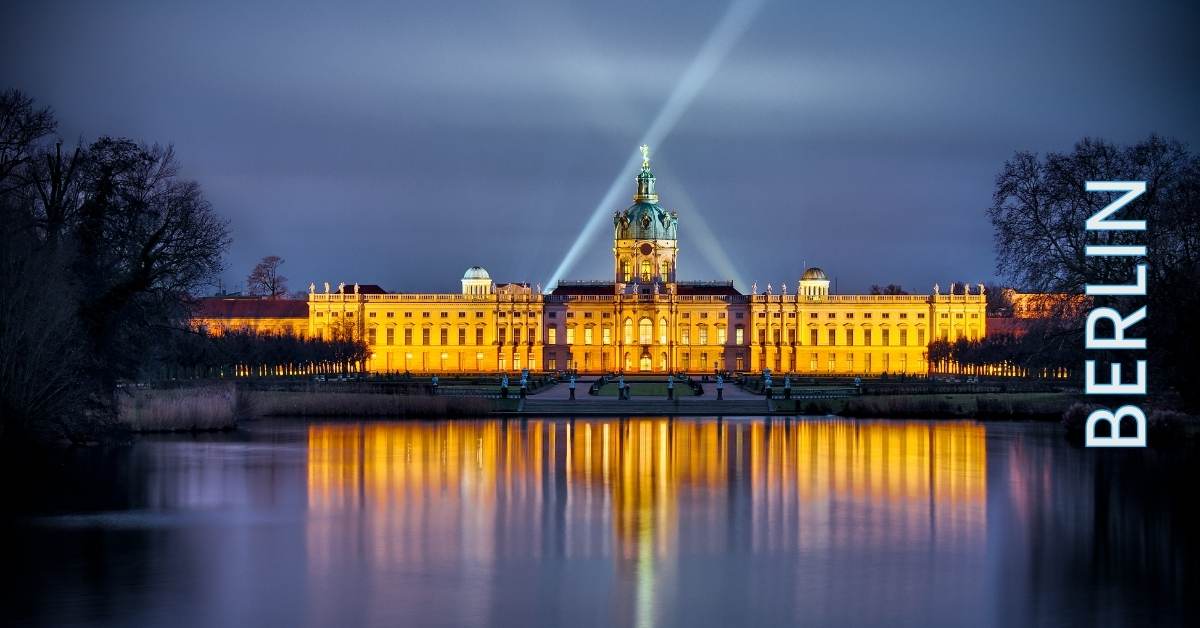 A view of Berlin's most famous must-see landmarks.
A view of Berlin's most famous must-see landmarks.Berlin sure brings a lot to the table when it comes to being the perfect spot for tourists and visitors. The wide variety of cuisines and popular German dishes, such as the famous döner kebab and currywurst! Schnitzel too. Yum!
It also offers many stunning cultural landscapes and remarkable sights of history, like the Brandenburg Gate and the nifty Museum Island (which you can find info on below).
These bring in a significant number of tourists alone, but what gained a lot of Berlin's fame is its batch of majestic castles and palaces.
On this page:
Castle Construction
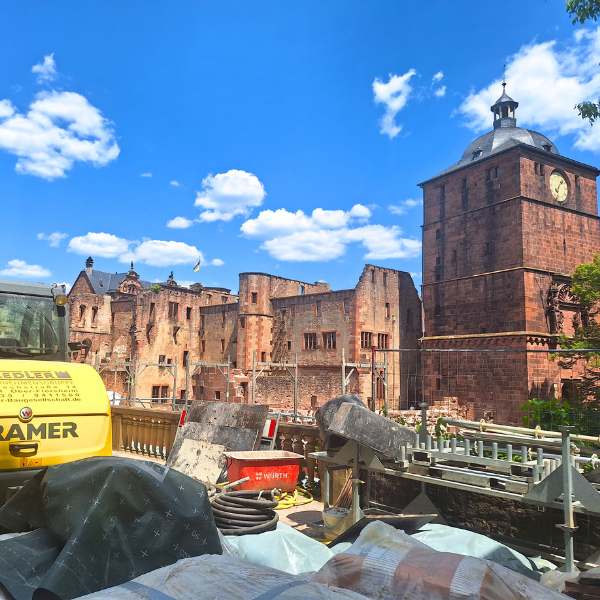
Note that these castles are old and sometimes require construction and upkeep. Be sure to check the official castle websites or local tourist stops to stay updated and informed of any construction in the castle to avoid a scene like this. After a trip up the mountain to see Heidelberg Castle, I was met with a lovely sight of an excavator instead. Stay in the loop on castle construction to plan your castle trip around it!
List of the Best Castles near Berlin
Charlottenburg Palace / Schloss Charlottenburg
Distance from Berlin: 5 miles (8 kilometers)
Travel by car: 26 minutes
Travel by transit (bus): 26 minutes
Berlin is host to the strikingly sizable 17th-18th century palace, commissioned by the elector of Brandenburg, Fredrich I's, wife, Sophie Charlotte.
The palace's original name was Lietzenburg, and after Sophie's death, was changed to Charlottenburg. In its later years, Fredrich was crowned king of Prussia, and he hired a wide variety of artists to help decorate and extend the palace.
Famous Prussian architects were called to bring their best to this residence and to make it stand apart from other Prussian palaces. There are self-guided tours as well as an audio-guided tour available. Pop some headphones on and stroll through time and elegance.
Charlottenburg is just a hop, skip, and jump away from the River Spree, a popular spot for boat tours.
Embark on a tour through the peaceful waters and learn about the surrounding scenic spots as you float past onto the next. Coming up to the long palace is the most beautiful view.
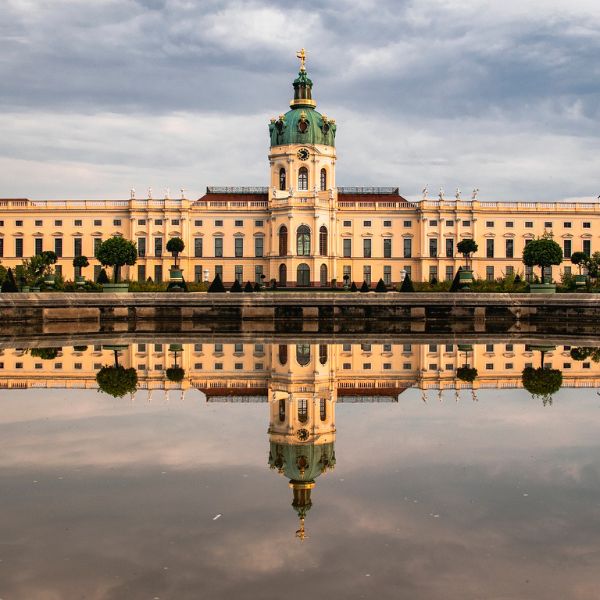 Now that's an impressive structure. Quite the view from the gardens!
Now that's an impressive structure. Quite the view from the gardens!~ Historic Fact ~
Napoleon made his way into Berlin and chose to make this very Charlottenburg his headquarters after his victory against the Prussian King, Fredrich III, in the battles of Jena-Auerstedt.
Architecture
The interior of the expansive Schloss is full of fun surprises, beautiful baroque architecture and ornate decoration. Of note in the palace are two alluring rooms to mention:
- The first is “The Amber Room” – A room which, sadly, is no longer a part of the palace. The room was completely covered in amber panels that coated the walls. Decorated with gold leaf, many mirrors, as well as candles, reflected the brilliant golden color all around, filling the room with a warm and stunning glow. It is not really known why it was removed, though there are, of course, many conspiracies surrounding the room's history.
- The second mention is something so unique. It's a must-see: the “Porcelain Room”. This room displays and features thousands of Chinese porcelain pieces, from floor to ceiling – from giant vases to the tiniest of plates. Incredible!
Now, let's head back outside to see the famous gardens. The charming palace is accompanied by the most lovely gardens, just as massive as the palace. As you walk past the front palace gate, you'll be greeted by the great statue of Fredrich, riding his noble horse.
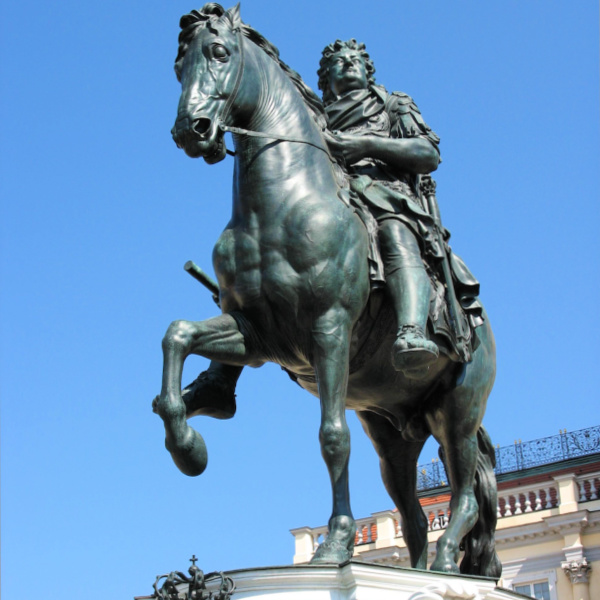 Fredrich II on his noble steed.
Fredrich II on his noble steed.
Make your way around the back of the palace to see the grounds filled with swirling pathways, hedges trimmed to perfection, statues, a large fountain, and relaxing benches to sit on right on the pond's edge.
One can truly see the creative mind and process that went into crafting this remarkable place.
Berliner Schloss / Berlin Palace
Distance from Berlin: 0.8 miles (1.3 kilometers)
Travel by car: 3 minutes
Travel by transit (bus): 7 minutes
While this is technically a new structure seen today, it was rebuilt identical to its old image and is packed with rich history and a truly beautiful story of rebirth. The Berliner Schloss also doubles as one of the five museums located on Museum Island, an island in Berlin that can be reached by bridges. The island itself is home to five separate massive museums.
The old royal palace, built in the 14th century, was used as a spot for important meetings and a residence for imperials and royalty. Many influential names in history visited and lived here. Kings, and emperors, and electors, oh my!
Sadly, taking hits from allied bombs in World War II, the Berliner Schloss was left severely damaged. Then, it was destroyed. But finally, the palace went into good hands in the early 20th century and began its construction to turn it back into the impressive structure it once was.
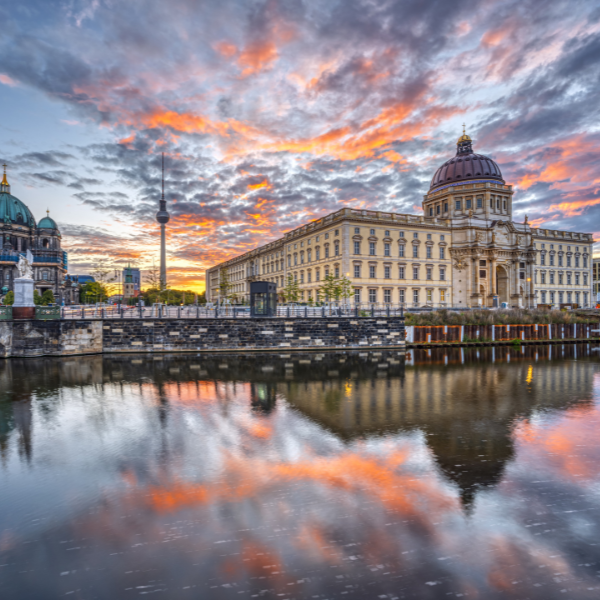 The Berlin palace located on the beautiful museum island only one minute from the cathedral! Can you spot its green domes in the background?
The Berlin palace located on the beautiful museum island only one minute from the cathedral! Can you spot its green domes in the background?Architecture
There are three inner courtyards and six entrances to the palace. And a new palace means new tourism!
This beauty features historical museum displays and a brand-new rooftop terrace. The new Humboldt Forum Museum is a fun and informative place to find beautiful fine art, learn about culture, science, and, of course, the past and future of this astonishing palace! This Berlin city palace offers even more!
It was rebuilt in a new baroque style and given a lovely café restaurant right at the top on the terrace. The cozy modern design, with a pleasant view of the city and a fantastic menu, gives the best experience.
What do you say? Is it time to visit Berlin's Museum Island and see this new, poised, and alluring baroque palace?
Don't forget to grab a tasty treat during the tour!
Babelsberg Palace
Distance from Berlin: 21 miles (33 kilometers)
Travel by car: 55 minutes
Travel by transit (bus): 1 hour
Earning a spot on the UNESCO World Heritage Site list, Babelsberg offers a view of the relaxing Havel River. Serving as a summer residence for German emperors and Prussian kings, this place is steeped in history.
The palace gives off that classic castle look with its dazzling towers and scenic atmosphere. The original palace is undergoing renovations, but is still standing as tall and beautiful as ever. It's open for special events and historic tours, showing the palace as a museum and showing off the grounds. There's so much to see!
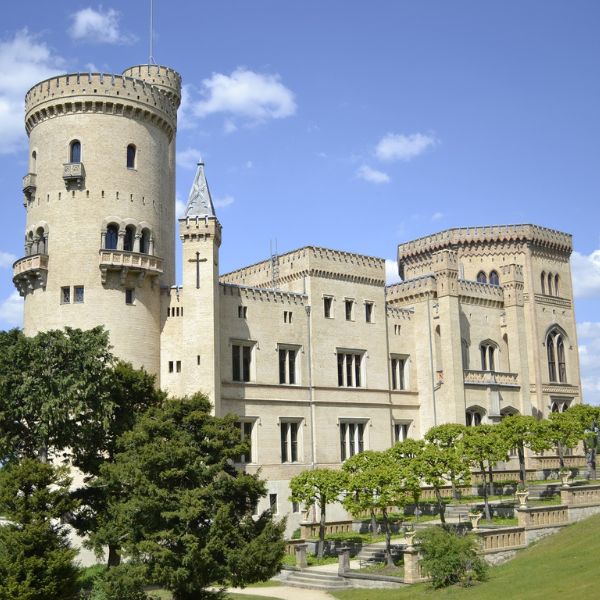 Tall and mighty, stands the grand Babelsberg!
Tall and mighty, stands the grand Babelsberg!Architecture
The gorgeous structure was built in a Gothic style, with high ceilings decorated with delicate white detail and wooden framing. The palace interior is nothing over the top like Bavaria's Neuschwanstein Castle, but its humble, cozy, and elegant flares are worth the stop along your Berlin travels.
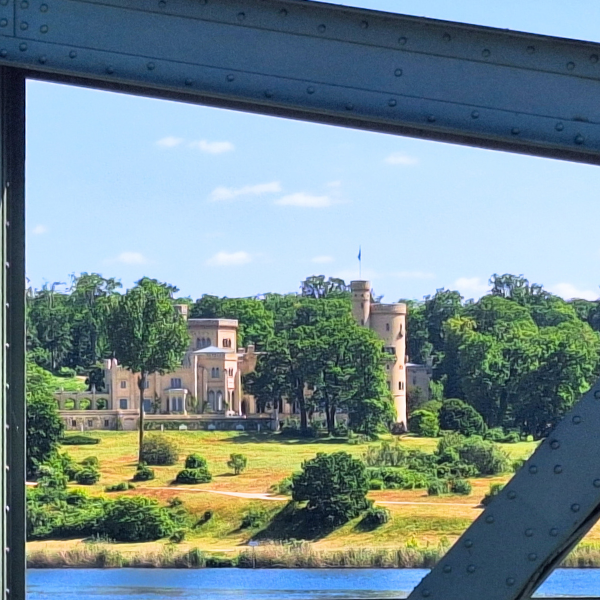 My view of Babelsberg palace through the Glienicke bridge.
My view of Babelsberg palace through the Glienicke bridge.Tour the museum inside and wander the admirable halls. Make your way down the welcoming staircase outside and enter the princess-movie-worthy gardens. The palace park and grounds feature romantic walking paths that take you by the river Havel and down rolling hills through the forest.
This is now a building project full of exciting new future tourist opportunities. Keep an ear out and soon everyone will be talking about the new and improved Babelsberg!
~ Travel tip ~
Be sure to ask or research before visiting the castles. Some have areas that are not allowed to be photographed. Ask your tour guide.
Just as one would in a museum, one always wants to be respectful of the rules. The historic buildings themselves, they are works of art too.
Glienicke Palace / Schloss Glienicke
Distance from Berlin: 18 miles (29 kilometers)
Travel by car: 50 minutes
Travel by transit (bus): 55 minutes
Close in location to the famous hunting lodge Glienicke and the Havel River, the once mere small country house has been erected into the summer retreat palace seen today.
The palace was designed in the 18th century with the creative eye of Prince Carl of Prussia, who sought to capture the Italian Neoclassical style of his dreams.
Visits are only allowed when accompanied by a tour guide, so do your research! There are some wunderbar tours to join to get a real glimpse into the history of these palaces that one may miss without a guide!
Alright, back to Glienicke. This darling little piece of Italy in Germany didn't only land a spot on the list of the best palaces/castles in Berlin, but it ALSO won a spot on the UNESCO World Heritage Site list.
The famous Prussian gardener who manicured the palace gardens certainly knew what he was doing. The beautiful pavilion surrounded by those luscious green arrangements and the terraces with climbing ivy are perfect.
The eye-catching antique stone fountain makes this palace a real fairytale destination. The lion statue and other arrays of statues are fascinating to learn about as well. Be sure to ask the tour guide a bit about those!
Architecture
Entering the Glienicke Palace is such an experience. Here one will see some of the most boldly painted palace interiors that have ever been seen before. There isn't one room that looks like the other, and this is super unique for palaces of this time. Truly a nice bright change from all the neutrals!
See the striking red hall, the ocean-blue library, and the turquoise bedroom?
But that's not all. The history of this palace has been well-preserved and is awaiting a visit from more travelers. Will you be one?
The museum displays original furnishings and the prince's artworks and will lead to a relaxing tour of the attractive gardens. But again, that's not all! The old carriage house has been turned into a snazzy restaurant.
Grab a traditional Berliner bite to eat after a long afternoon of taking in Glienicke's beauty.
Jagdschloss Grunewald
Distance from Berlin: 12 miles (20 kilometers)
Travel by car: 42 minutes
Travel by transit (bus): 1 hour
This 15th-century hunting lodge is the oldest preserved palace in all of Berlin! Now that is an impressive title to hold! Owned during the Middle Ages by the grand elector of Brandenburg, it was later redesigned by the Prussian King Fredrich and his hired builder to bring a baroque style to the lodge. Elector Hector owned Grunewald Lodge as part of his collection of lodges.
Throughout his years, Hector built several hunting lodges scattered about in hidden forest areas for privacy and the perfect secluded fortress. Among all of them, Grunewald is the only and best surviving example of his taste and ideas.
The name Zum grünen Wald was given to the lodge, meaning 'to the green forest'. Grunewald is the name of that green forest where it is located. But the name Grunewald Hunting Lodge stuck … plus it's a bit quicker and easier to say.
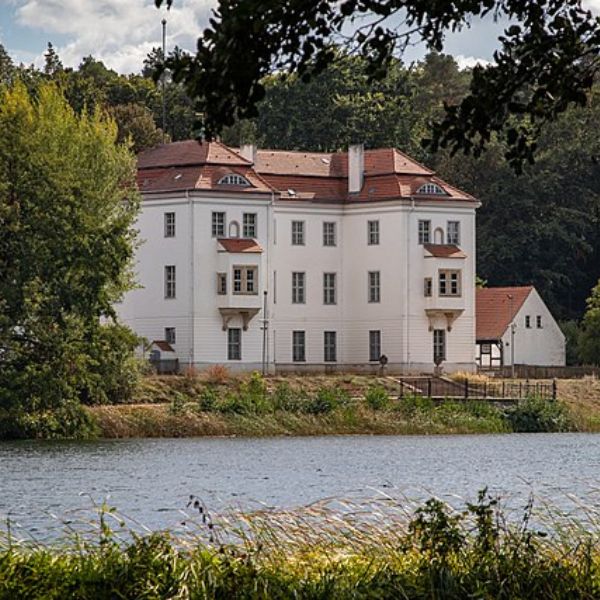 Imagine THIS being your hunting lodge. Not a simple deer stand. A whole palace!
Imagine THIS being your hunting lodge. Not a simple deer stand. A whole palace!Architecture
The structure has a delightful view over the lake and is a popular tourist destination among locals and travelers. The first original lodge had a small moat around it, and while undergoing renovations the first time, bits and pieces of the palace were tossed into it. Then the moat was filled in, leaving the treasures to be uncovered later.
Now the museum inside Grunewald displays the Renaissance pieces discovered. Also found during repairs were original Renaissance cast iron plates from a stone box. So cool to find pieces of history from so long ago!
Inside, one can find the largest painting collection in Berlin: artworks from the Prussian royal homes, nine massive panels once belonging to a famous church, and a hunting museum. In this museum, see the collection of wheel lock weaponry from Berlin's armory, as well as handguns and pistols of the Prince of Prussia.
If you like taxidermy, you can learn about it here! In addition, you can see some of the original works that were hunted and taxidermied in the lodge centuries ago.
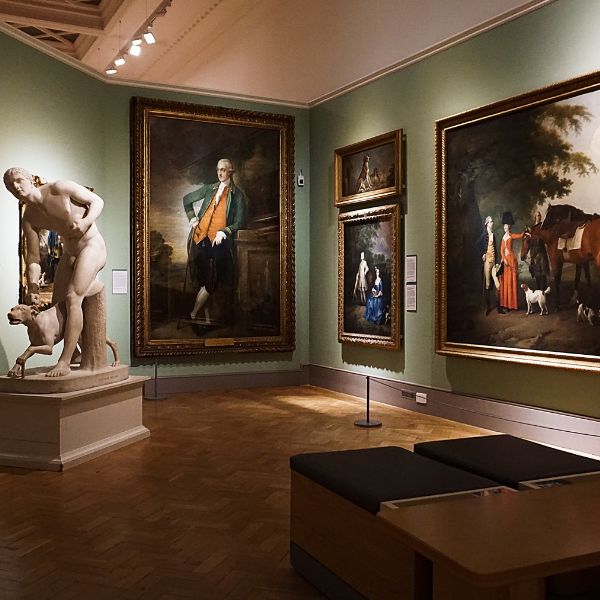 Men with ponytails in paintings will be a common theme in a lot of the castle museums.
Men with ponytails in paintings will be a common theme in a lot of the castle museums.~ Fun Fact ~
Did you know that Grunewald has been used as a backdrop for movies and TV shows from as early on as 1967? Popular action films like Wild Goose II and the children's series, Schloss Einstein, just in 2007!
Bellevue Palace / Schloss Bellevue
Distance from Berlin: 2.5 miles (4 kilometers)
Travel by car: 11 minutes
Travel by transit (bus): 6 minutes
Built really fast, completing construction in only one year at the end of the 17th century, Bellevue is a big palace nicknamed the “White House of Berlin”. Why? Well, it is the official residence of the president of Germany.
Most people know of Fredrick the Great and his reign. The palace actually started off its time by serving as a residence and private home to his young brother, Ferdinand, the Prince of Prussia. But that's not all.
Bellevue also served as a school for many years. The name 'Bellevue' is French, meaning 'beautiful view'—and that, it sure does have! The palace grounds are stunning and make for the perfect romantic stroll.
The grounds are what led the palace to receive that well-deserved name, as they are manicured so well and shaped with lovely hedges leading right to the banks of the trickling Spree River.
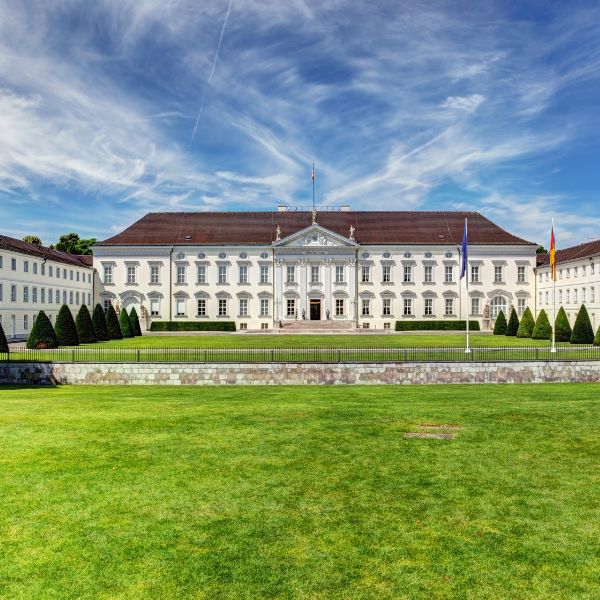 Berlin's very own White House!
Berlin's very own White House!Architecture
Guided tours are available for this gem, but do have to be booked fairly far in advance. After all, it is still someone's home and many crucial meetings happen in these walls. We wouldn't want any travelers and tourists popping into the wrong room while big decisions are being made!
The palace architecture is completed with an elegant neoclassical style, and the interior as well. The palace boasts of classical elements.
Visitors often expect more extravagance from such an important palace but are met with a cozy interior instead. It's almost more welcoming that way … and less intimidating!
Expect to see the occasional guard hanging around and wandering from room to room. So be on your best behavior.
~ Fun Fact ~
Can you spot the presidential flag? It's nearly always flown, only taken down to half-mast when the president is not currently staying in the residence and is away on business.
Spandau Citadel
Distance from Berlin: 10 miles (15.5 kilometers)
Travel by car: 45 minutes
Travel by transit (bus): 30 minutes
This unique medieval castle and military fortress, built in the mid-late 1500s to defend the city of Spandau, has since become a part of the unbeatably beautiful Berlin. Added to the original castle building – the place was constructed and remodeled into the Citadel that can be visited and enjoyed today.
The fortress is full of rich history and stories of rebirth and standing mighty and strong to defend troops during the many battles. The poor castle suffered damage during the Fall of Berlin, but was rebuilt and stood to protect its own troops once more in the Battle of Berlin.
The drawbridge served as excellent protection and hiding spot for the troops to surprise the enemy. Also serving as a school and a prison, this place has been through it all and seen some very significant points in history.
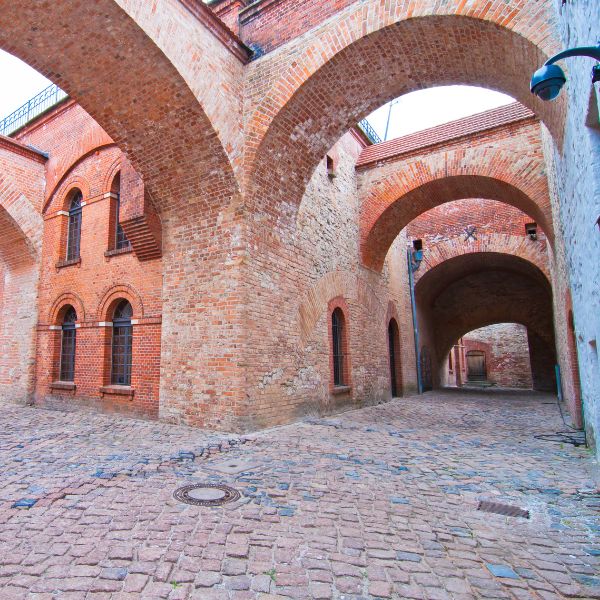 The connecting courtyards of Spandau. SO cool. No wonder bats love it.
The connecting courtyards of Spandau. SO cool. No wonder bats love it.~ Historic Fact ~
An army gas laboratory with over 300 scientists worked on developing chemical weapons and discovered the use of nerve gas in this very fortress.
Architecture
There is so much to do when visiting the fortress, which is just a short walk to the old town of Spandau. Create a day trip out of it! The old beauty was decorated in a Renaissance-Italian architectural style. But it looks so unique and certainly stands out above the bunch.
Wedged between the two rivers, Spree and Havel, the island hosting the fortress also holds a collection of buildings where many events and celebrations are held throughout the year. The spacious grounds have become a favorite among locals to use as a concert venue. So original! Museums, of course, are found inside and all around the complex on the island as well.
But the mighty fortress didn't just serve as a mighty protecting shelter for humans. To this day, it is also the safe haven of over 10,000 BATS! That's right. They're not here all year.
Only in the winter do thousands of the clever creatures seek shelter in the fortress's old, cozy bricks. So, no worries. You won't have bats flying at your heads during your summer tours and concerts.
On that fun note, that's all for now! Thanks for coming along on our quick tour of the best palaces and castles in Berlin! But don't think it all stops here. There is more history, knowledge, incredible architecture and photos to be taken on your travels in Berlin. The adventures are never over!
How Many Castles Are There in Germany?
How Many Castles Are There in Germany?
There is estimated to be over 20,000 castles in Germany!
How Many Döner Kebabs are Eaten Every Day in Berlin?
How Many Döner Kebabs are Eaten Every Day in Berlin?
It is estimated that 60 tonnes of Döner Kebab using 950 spits of meat are eaten daily in Berlin.
